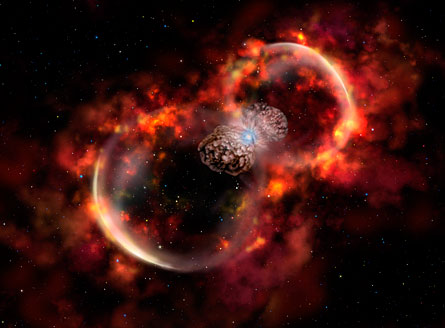New observations suggest that the brilliant outburst of a hefty star that first wowed observers in the 1840s could be signs of a new, exotic type of stellar explosion.

For centuries, the star Eta Carinae had appeared to be a run-of-the-mill Milky Way resident. But in late 1837, this sleeping giant awoke. By 1843 it had become the second-brightest object in the night sky. Over the next 13 years, the massive star cast off two billowing, mushroom-shaped clouds of material. The star then faded but, a decade ago, unexpectedly increased in brightness and is now visible to the naked eye.
Researchers had thought that the outburst was driven by a strong stellar wind that ejected the star’s outer layers, creating a brighter-looking star. Massive stars such as Eta Carinae are known to generate such winds. But a report in the Sept. 11 Nature, which details the discovery of extremely high-speed material hurled from Eta Carinae, suggests that a stellar wind wouldn’t have the oomph to cast off debris at such velocities.
Instead, study author Nathan Smith of the University of California, Berkeley suggests something more powerful — a new kind of deep-seated explosion — triggered the 1840s outburst and perhaps others that the star has undergone.
The explosion couldn’t have been as strong as a full-fledged supernova, he notes. Otherwise the star — heavy and old enough to be teetering on the brink of dying as a supernova — would already have been blown to bits. Moreover, Eta Carinae’s outbursts may be similar to those spotted during searches for supernovas in other galaxies. These surveys have found explosions, dubbed supernova imposters, that appear similar to supernovas but are not as energetic.
“If the supernova imposters in other galaxies are related to what happened with Eta Carinae, it means that this group of objects constitutes a new type of celestial explosion that we have yet to understand, but it is widespread and must play an important role in the evolution of massive stars,” says Smith.
Smith’s results “show that Eta Carinae might be the nearest of all massive stars that exhibit violent eruptions before exploding as a supernova at a later stage, and that these eruptions might be more energetic than previously thought,” says Stefan Immler of NASA’s Goddard Space Flight Center in Greenbelt, Md. “Even though we still don’t know what physical process creates these eruptions, [Smith] convincingly argues that due to the large amount of energy released, they might be powered by an explosion mechanism that is more similar to energetic supernovas than to [wind-related] instabilities in the outer layers of stars.”
Located some 7,500 light-years from Earth, Eta Carinae is a whopping 90 to 100 times as heavy as the sun and is known to have a much lower-mass partner. The star is also surrounded by a double-lobed cloud of gas and dust known as the Homunculus nebula, which was expelled during the 1840s outburst.
The material associated with the nebula moves at 650 kilometers per second, slow enough to have been ejected by the star’s wind. But new observations by Smith using two telescopes in Chile reveal filaments of gas, also expelled during the 1840s outburst, that are moving at five times the speed of the debris in the Homunculus — too high to have been driven off by a wind.
Unlike a wind-driven event, an explosion “implies that there is some sudden burst of energy deep inside the star,” Smith says. “It may be related to the rate of fuel consumption as a massive star nears the end of its life.”
Ted Gull of NASA-Goddard cautions against focusing solely on the interpretation of a novel stellar explosion mechanism. Instead, he says, the gravity of Eta Carinae’s low-mass partner, which is believed to closely approach the heavyweight star every 5.54 years, might have triggered the 1843 outburst.







